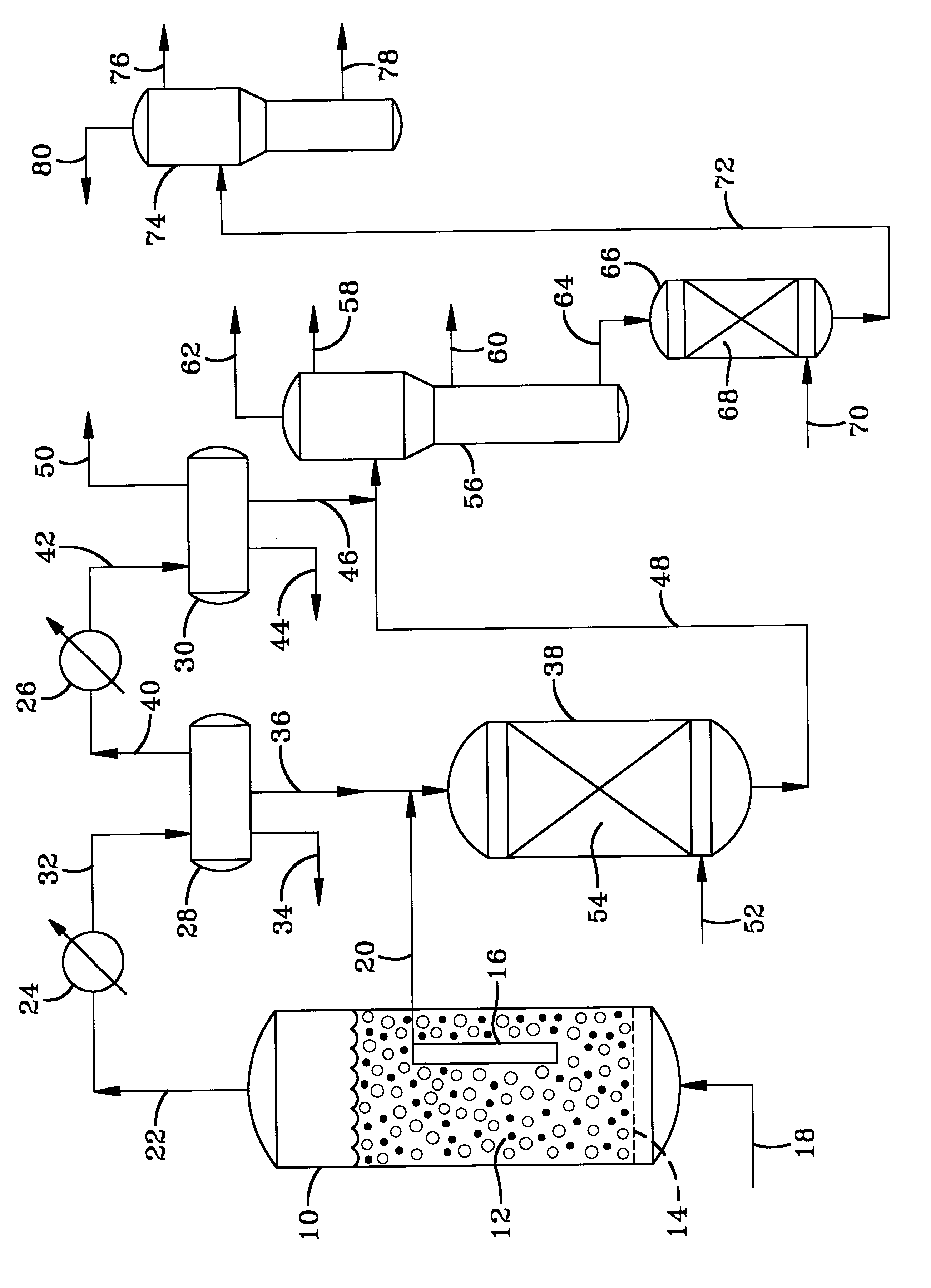Isoparaffinic base stocks by dewaxing fischer-tropsch wax hydroisomerate over Pt/H-mordenite
a technology of fischer-tropsch wax and isoparaffinic base stock, which is applied in the direction of hydrocarbon oil treatment products, physical/chemical process catalysts, metal/metal-oxide/metal-hydroxide catalysts, etc., can solve the problems of adverse effects, high cost of additives, and tendency to undergo degradation
- Summary
- Abstract
- Description
- Claims
- Application Information
AI Technical Summary
Problems solved by technology
Method used
Image
Examples
example 1
Fischer-Tropsch synthesized waxy hydrocarbons were formed in a slurry reactor from a synthesis gas feed comprising a mixture of H.sub.2 and CO having an H.sub.2 to CO mole ratio of between 2.11-2.16. The slurry comprised particles of a Fischer-Tropsch hydrocarbon synthesis catalyst comprising cobalt and rhenium supported on titania dispersed in a hydrocarbon slurry liquid, with the synthesis gas bubbled up through the slurry. The slurry liquid comprised hydrocarbon products of the synthesis reaction which were liquid at the reaction conditions. These included a temperature of 425.degree. F., a pressure of 290 psig and a gas feed linear velocity of from 12 to 18 cm / sec. The alpha of the synthesis step was greater than 0.9. The waxy feed, which is liquid at the reaction conditions and which is the slurry was withdrawn from the reactor by filtration. The boiling point distribution of the waxy feed is given in Table 1.
example 2
The waxy feed produced in Example 1 was hydroisomerized without fractionation and therefore included the 29 wt. % of material boiling below 700.degree. F. shown in Table 1. The waxy feed was hydroisomerized by reacting with hydrogen in the presence of a dual function hydroisomerization catalyst which consisted of cobalt (CoO, 3.2 wt. %) and molybdenum (MoO.sub.3, 15.2 wt. %) supported on an amorphous silica-alumina cogel acidic component, 15.5 wt. % of which was silica. The catalyst had a surface area of 266 m.sup.2 / g and a pore volume (P.V..sub.H2O) of 0.64 mL / g. This catalyst was prepared by depositing and calcining the cobalt component on the support prior to the deposition and calcining of the molybdenum component. The conditions for the hydroisomerization are set forth in Table 2 and were selected for a target of 50 wt. % feed conversion of the 700.degree. F.+ fraction which is defined as:
700.degree. F.+ Conv.=[1-(wt. % 700.degree. F.+ in product) / (wt. % 700.degree. F.+ in fee...
example 3
The 700.degree. F.+ hydroisomerate shown in Table 3 was catalytically dewaxed using a 0.5 wt. % Pt / H-mordenite catalyst to reduce the pour point and form a high VI lubricating base stock. In this experiment, a small up-flow pilot plant unit was used. The dewaxing conditions included a 750 psig H.sub.2 pressure, with a nominal treat gas rate of 2500 SCF / B at 1 LHSV and a temperature of 550.degree. F. The dewaxate product exiting the reactor was fractionated using the standard 15 / 5 distillation to remove the lower boiling fuel components produced by the dewaxing and the 700.degree. F.+ product subjected to Hivac distillation to obtain narrow cuts, with low temperature properties measured on the 730-950.degree. F. and 950.degree. F.+ portions. The results are summarized in Table 5.
The properties of the Fischer-Tropsch base stock prepared according to the process of the invention are compared with those of the lube oil base stock derived from the Arab Light feed in Table 6.
The propertie...
PUM
| Property | Measurement | Unit |
|---|---|---|
| Angle | aaaaa | aaaaa |
| Temperature | aaaaa | aaaaa |
| Temperature | aaaaa | aaaaa |
Abstract
Description
Claims
Application Information
 Login to View More
Login to View More - R&D
- Intellectual Property
- Life Sciences
- Materials
- Tech Scout
- Unparalleled Data Quality
- Higher Quality Content
- 60% Fewer Hallucinations
Browse by: Latest US Patents, China's latest patents, Technical Efficacy Thesaurus, Application Domain, Technology Topic, Popular Technical Reports.
© 2025 PatSnap. All rights reserved.Legal|Privacy policy|Modern Slavery Act Transparency Statement|Sitemap|About US| Contact US: help@patsnap.com

